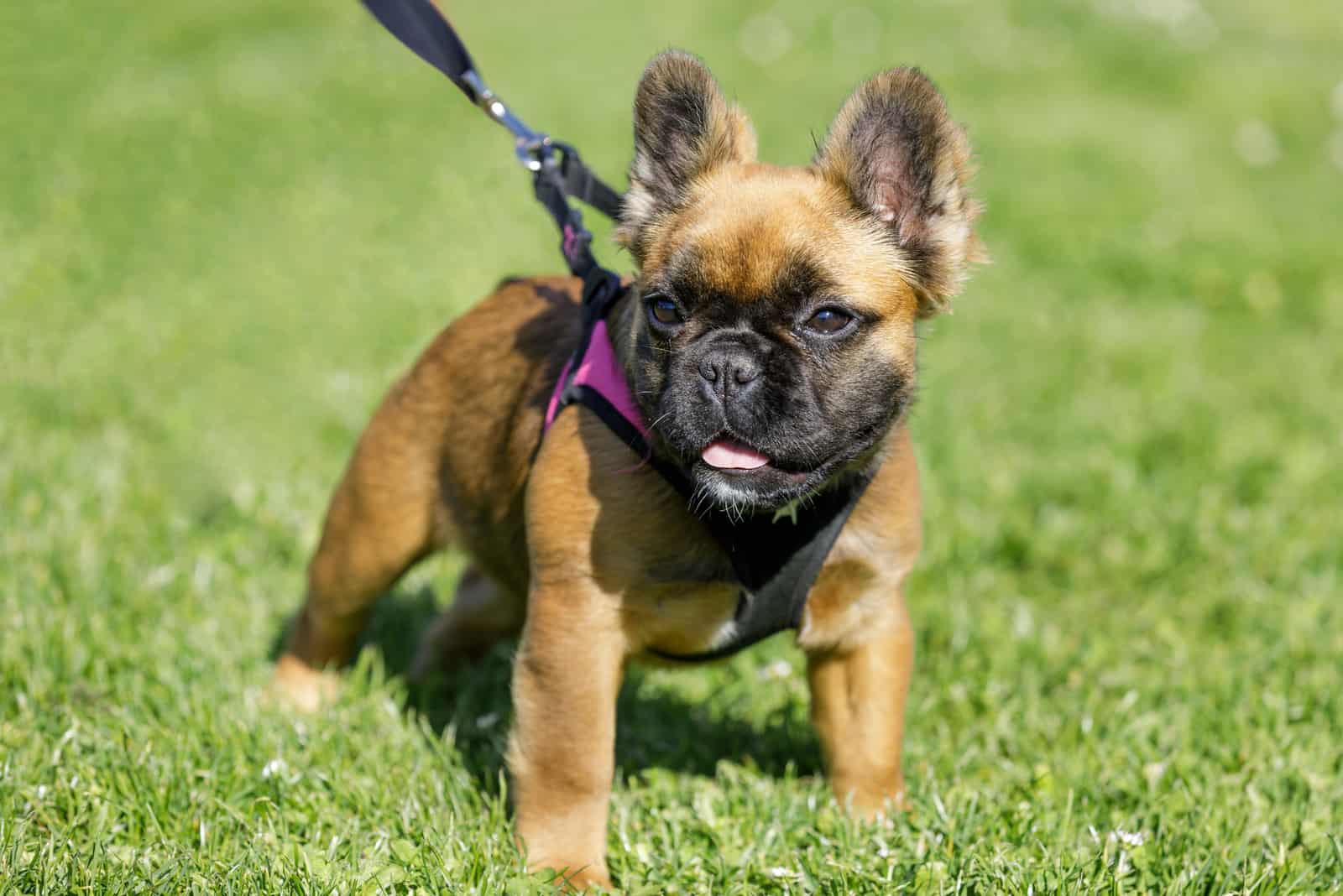We all know what a Frenchie looks like. After all, they’ve been accompanying countless celebrities from the 19th century till today. Short-haired, bat-eared, and unbelievably adorable, right?
Well, the short-haired part isn’t always true. Although they are rare and very expensive, Fluffy Frenchies do exist. They are 100% French Bulldogs, not mixed-breeds as some believe.
If you have ever seen a long-haired Frenchie and wondered how that is possible, we will help you solve the mystery. Those of you who would like to get yourselves a Fluffy French Bulldog puppy will have an easier time deciding after reading this article.
What is a Fluffy Frenchie?

A Fluffy Frenchie or a long-haired Frenchie is a rare variation of the French Bulldog breed. In fact, they’re so rare that many doubted their existence when they first started gaining popularity on the internet a few years back.
However, Fluffy Frenchies are real, and the abundance of internet pics is there to prove it.
But, why are some French Bulldogs born with long hair?
The answer lies in their genetic makeup. The DNA tests have shown that long-haired French Bulldogs possess the Fibroblast Growth Factor 5 (FGF 5), an autosomal recessive gene responsible for their long coats.
When two French Bulldogs that carry the FGF 5 are bred, there’s a 25% chance of their puppies being born with long hair.
The Fluffy Frenchie bulldogs have two copies of the long hair gene, called L1 or L4, which is why they display this trait. On the other hand, their parents have one copy of L4 and one copy of the short hair gene (Sh).
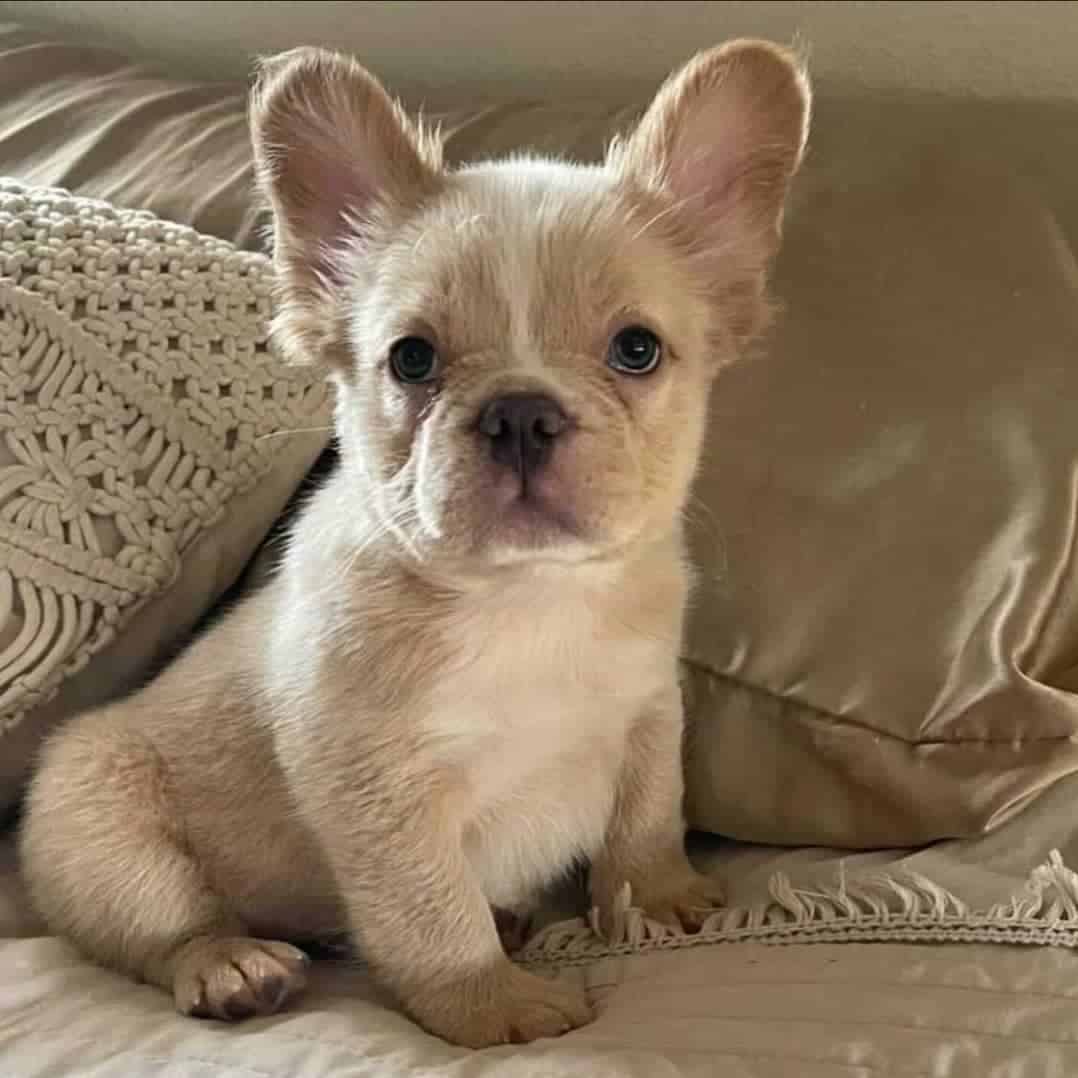
Since the Sh gene is dominant, they look like classic French Bulldogs that carry two copies of the short hair gene.
For example, in humans, the brown-eye gene is dominant, but two brown-eyed parents can still give birth to a blue-eyed baby if they both carry the blue-eye gene.
As we can see, there’s nothing wrong with long-haired Frenchies. They’re as cute as their short-haired cousins, just slightly different and less common.
Are Fluffy Frenchies purebred?
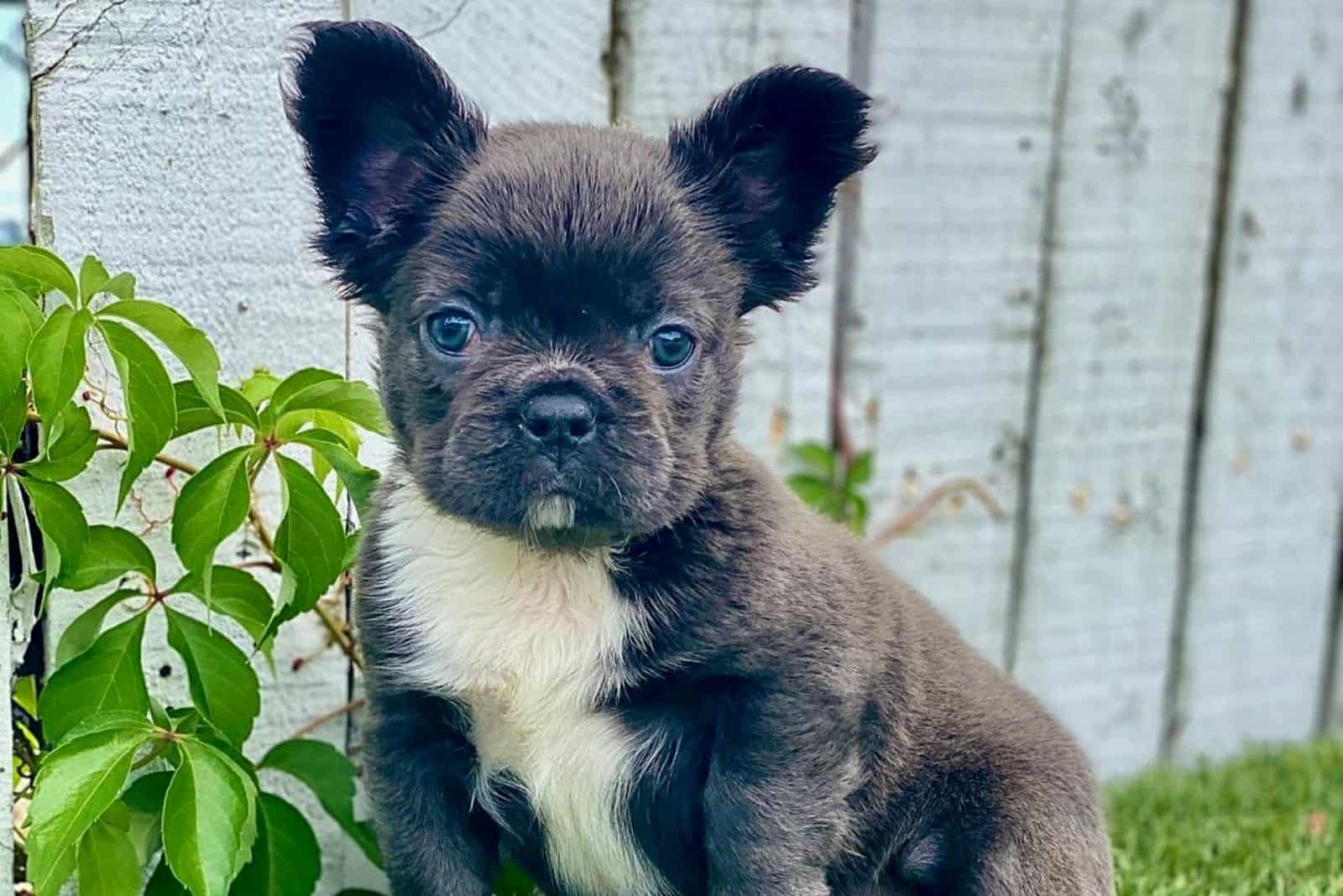
Many people believe that Fluffy Frenchies are a mixed breed due to their unusual appearance. Nevertheless, they are purebred, meaning they are born to two purebred French Bulldogs.
However, the American Kennel Club and other canine organizations don’t allow long-haired French Bulldogs to be registered because they don’t fit the dog breed standards.
When you think about it, all the purebred dogs of today were hybrids at one point in time. People have been crossing different dogs to get the desired traits for centuries.
The classic French Bulldog was created in the 1800s by crossing the English Bulldog with local terriers or ratter dogs to reduce their size. When these small, funny-looking pups found their way to France, they became popular among high-society circles.
Their popularity never stopped rising, which is why Frenchies were the second most popular dogs in the USA in 2020.
One theory that explains the presence of the long-haired gene in French Bulldogs involves these ratter dogs. The terriers had medium- to long-length coats, so their genes were passed down to their descendants.
The demand for Fluffy Frenchies has increased in recent times. Trying to make a quick buck, some breeders crossed French Bulldogs with Chihuahuas or Pekingese to get the long hair effect.
This shouldn’t happen if you get your puppy from a reputable breeder who allows you to meet its parents. If you would still like to make sure that your pup is 100% French Bulldog, you can have it undergo a breed identification test.
What do they look like?
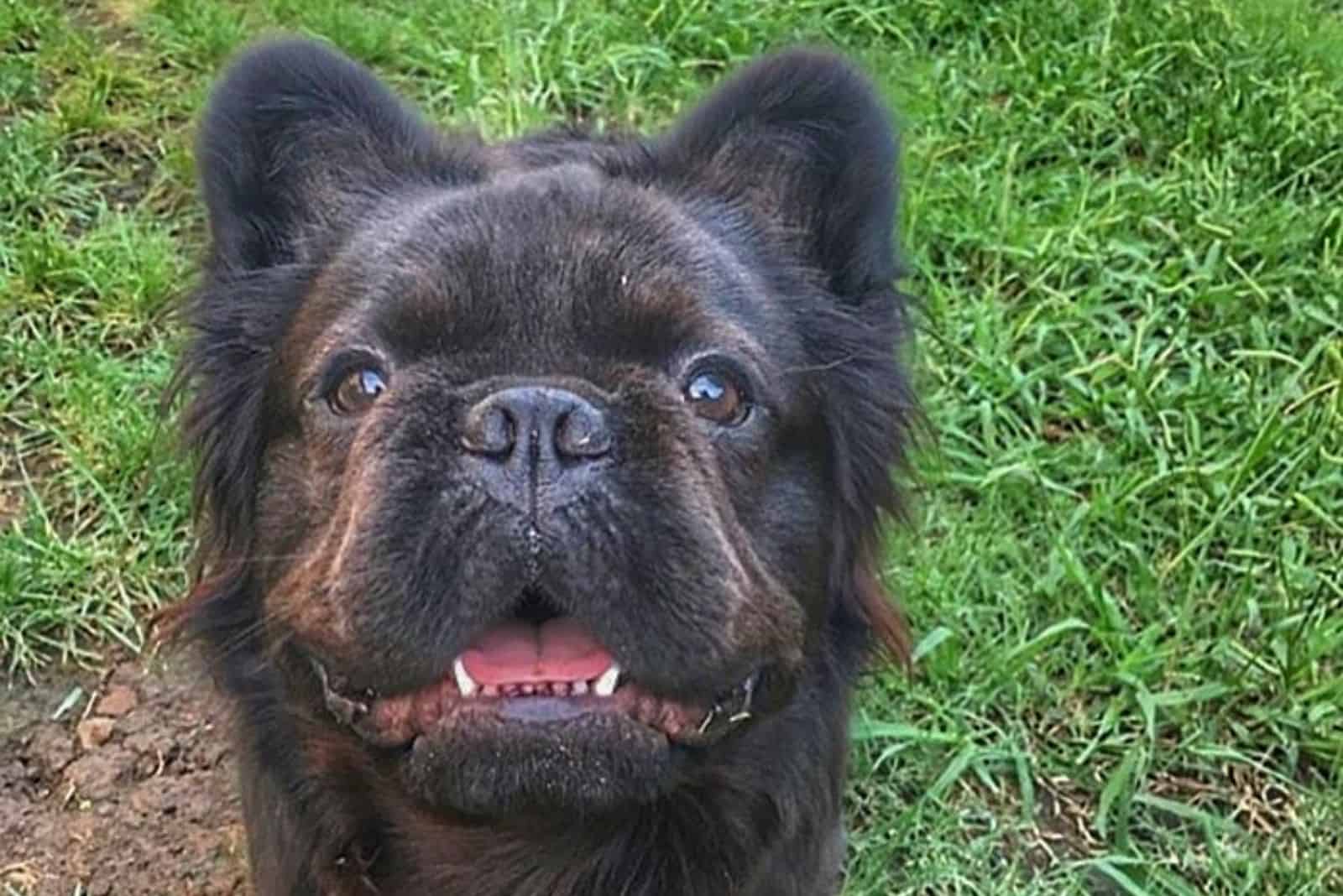
The ”new hair-new me” phrase doesn’t apply to Fluffy French Bulldogs. They look pretty much the same as their short-haired relatives, apart from the difference in their coat lengths.
They are small-sized dogs with a muscular, compact build. They grow to be 11 to 13 inches tall. The AKC doesn’t allow pups heavier than 28 pounds to participate in dog shows.
Males typically weigh more, between 20 and 28 pounds, while the females are somewhat lighter, with a weight of 16 to 24 pounds.
Frenchies are known for their adorable squished faces, with short, broad muzzles and noses. Not many puppies could go up against them in the cutest dog contest.
With wrinkled foreheads and a permanently sad look in their eyes, these cuties are impossible to resist. We understand if you want to give them a treat every time they look at you, but don’t go overboard. Weight issues can lead to serious health concerns.
The signature look of Frenchies is their bat-like ears. However, not many people know that French Bulldogs can also have rose-shaped and floppy ears. The AKC considers this ear shape as a disqualifying characteristic, but many European breeders initially prefer it.
What makes long-haired French Bulldogs different from other Frenchies is their medium-length wavy coats. Their mane, chest, and ears have the most pronounced fluff, and the fur of these pups comes in a variety of colors and markings.
If you love your fluffy Frenchie, then you definitely want only the best for your pup. How about you check out the finest dog gear suitable for Frenchies?
[table id=193 /]
What are their personalities like?
Every French Bulldog puppy has a unique personality, but in general, they tend to be playful, affectionate, easygoing, patient, and friendly pooches.
They are companion dogs, so they like to spend every moment they can with their owners. These fluffy dogs are not suitable pets for people who don’t spend much time at home since they are prone to separation anxiety.
They can get along great with both children and other animals, making them excellent family dogs. Nonetheless, Frenchies love being the center of attention, so you should never make them feel ignored.
French Bulldogs are usually not big barkers, which is why they’re suitable for apartment living. If you live in a thin-walled apartment surrounded by easily annoyed neighbors, then a Frenchie may be just the right pup for you.
Despite their lively personality, they don’t need a lot of exercise. A short daily walk is enough to tire them out.
Being the intelligent pups they are, long-haired French Bulldogs are highly trainable. All you need to do is provide enough treats and praise and they’ll quickly learn any trick.
It’s uncommon for them to develop behavioral issues. When they do, it is usually due to boredom or stress. Keep your puppy entertained and there won’t be any problems.
Coat colors of long-haired Frenchies
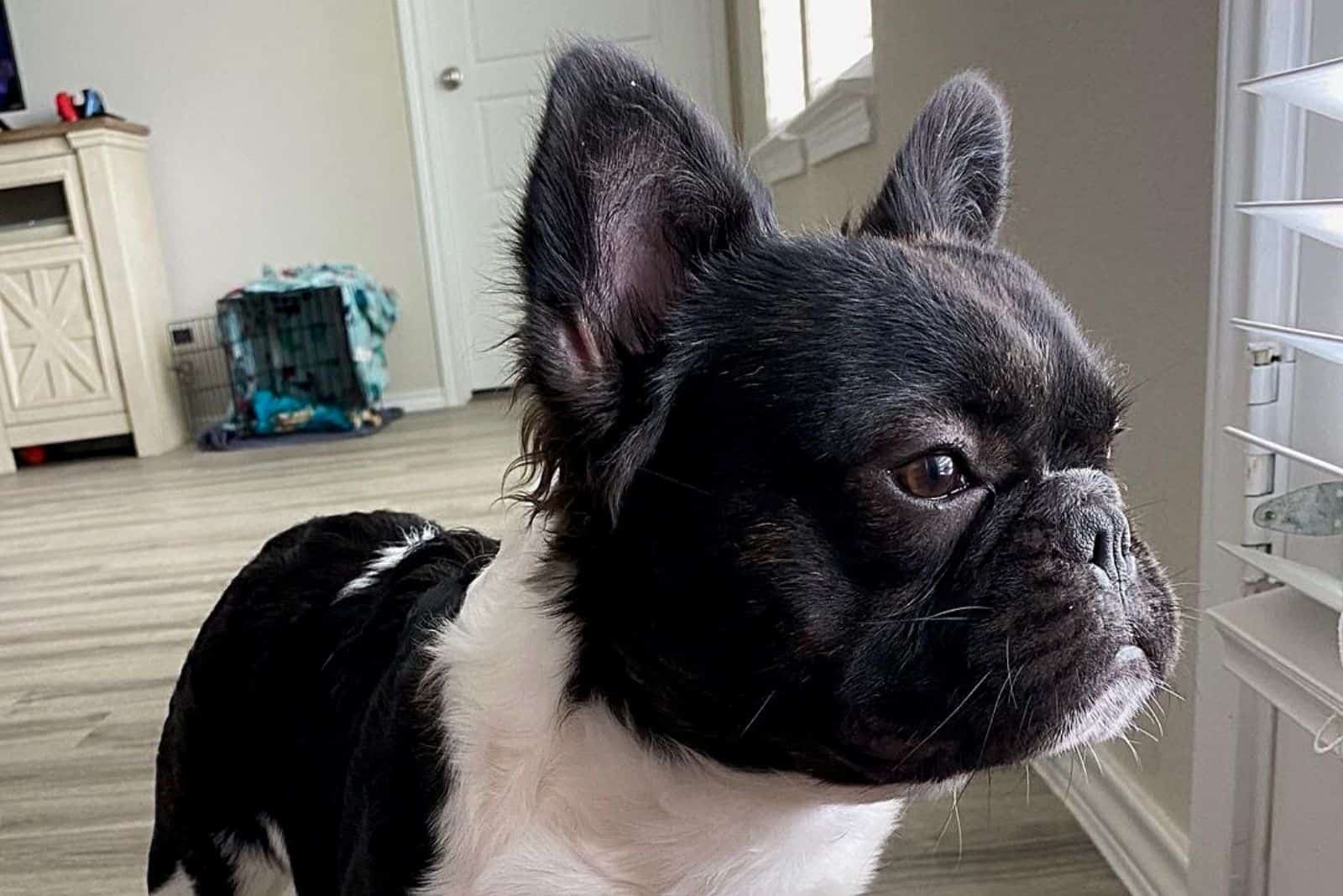
The coats of long-haired French Bulldogs come in all the same colors and markings as their short-haired counterparts.
The AKC -approved coat colors are:
1. White.
2. Cream.
3. Fawn,
4. Or, any combination of them.
According to them, the acceptable markings and patterns are:
1. Brindle.
2. Piebald.
3. Black masks.
4. Black shadings.
5. White markings.
6. Ticked.
A brindle or tiger-striped coat pattern has different shades of red as the base color, with black stripes on top. A piebald dog has black spots on top of the white base. The opposite would be dogs with white markings, which appear as areas of white on a darker base color.
A black mask means the area around the muzzle is black. This is a very common marking for Frenchies. Dogs with ticked coats have spots of color on the white background.
French Bulldogs of all other colors and markings aren’t allowed to enter their shows. Even if Fluffy Frenchies fit the color standard, they still can’t be registered due to their long hair.
The coat colors listed above are the most common for this breed. Although they are rare, French Bulldogs can also be:
1. Blue.
2. Lilac.
3. Blue and tan.
5. Blue merle.
The rare-colored Frenchies, such as sable, pied, or cream, are usually more expensive; therefore, many backyard breeders started irresponsibly breeding them to get the desired color. This is the reason why they can be more prone to health issues.
We can’t emphasize the importance of getting your puppy from a reputable breeder enough.
That way, you won’t be supporting unethical breeding processes, and it will also save you from possible costly vet bills.
Do Fluffy French Bulldogs shed?
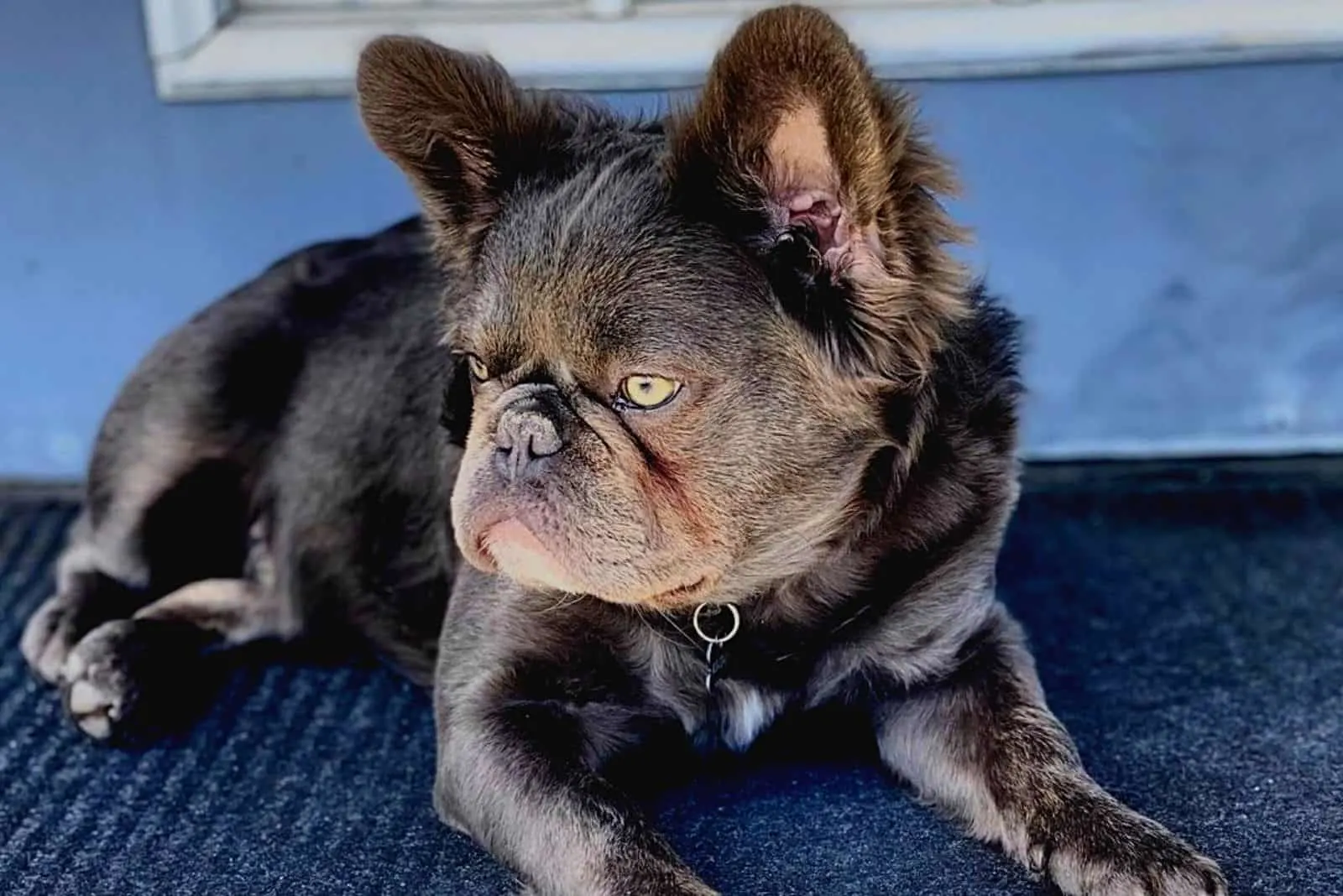
All dogs shed, and Fluffy Frenchies are no exception. They don’t shed more compared to their short-haired cousins, but it’s more noticeable as their hair is longer.
French Bulldogs don’t leave much hair lying around the house since they are typically not high shedders. Their small size also reduces the amount of hair you need to clean up in your home.
However, Frenchies ’ coats require extra attention during spring and fall. They shed their undercoats and grow lighter ones in preparation for hot summer days. Once the fall comes, they shed these summer coats and replace them with thicker ones to keep them warm during winter.
Regular grooming can minimize the amount of shedding. You can brush their coats weekly with a glove brush or a bristle brush. Also, bathing them twice a month can help get rid of any loose hair that doesn’t fall out on its own.
If your long-haired Frenchie is shedding excessively, it could be a sign of medical problems. Abnormal shedding can also be caused by poor nutrition and stress.
Therefore, it’s important to properly take care of your furry companions, so their shedding tendencies won’t be much of a problem.
Health issues
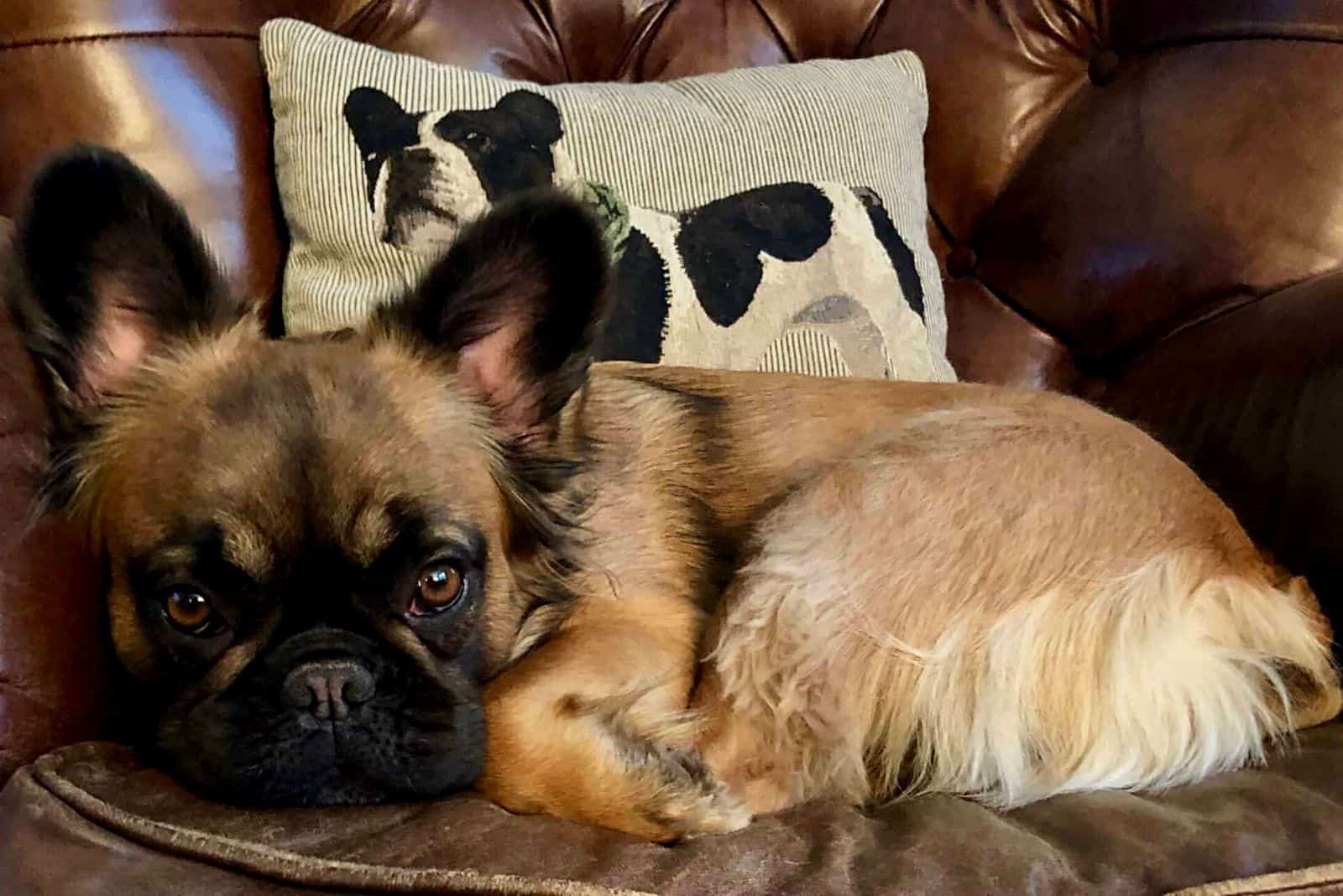
Unfortunately, Frenchies face several health issues throughout their lives.
Most French Bulldogs have breathing difficulties due to their flat faces. That’s why these adorable pups make all sorts of noises, like snoring and snorting.
Other dogs with such problems include Pugs, Pekingese, Chihuahuas, and English Bulldogs, and they’re commonly referred to as brachycephalic breeds.
The most common health problems for French Bulldogs are:
• Brachycephalic Obstructive Airway Syndrome (BOAS), which leads to shortness of breath, sleeping difficulties, and heat intolerance.
• Hip dysplasia, which is a condition where the ball and socket of the hip joint don’t fit correctly. The symptoms include decreased activity, inability to jump or climb stairs, and hip pain.
• Patellar luxation, which is a condition characterized by recurrent dislocation of the kneecap. A dog with this disease can have minor symptoms, where the kneecap returns to its place naturally. However, a dog may need surgery if the condition progresses to its highest grade.
• Intervertebral Disc Disease (IVDD), which affects many small-breed dogs. This occurs when the discs between the vertebrae bulge or burst into the spinal cord space, leading to paralysis.
• Conjunctivitis or pink eye, which is also very common in Frenchies. This can be caused by bacterial infections, allergies, or a dry eye disorder. If you notice that your pup is blinking more than usual or has bloodshot eyes and eye discharge, you should contact a vet and start treatment.
• Ear infections, which are usually caused by allergies. When the infection is not dealt with in time, it can lead to serious problems and a lot of pain for your pooch.
• Skin Fold Dermatitis, which often develops because of the folded skin on a Frenchies ’ face. Cleaning their wrinkles as part of regular grooming should help prevent this.
French Bulldogs are also prone to having upset stomachs, which is why a proper diet is essential for this breed.
How much do Fluffy Frenchies cost?
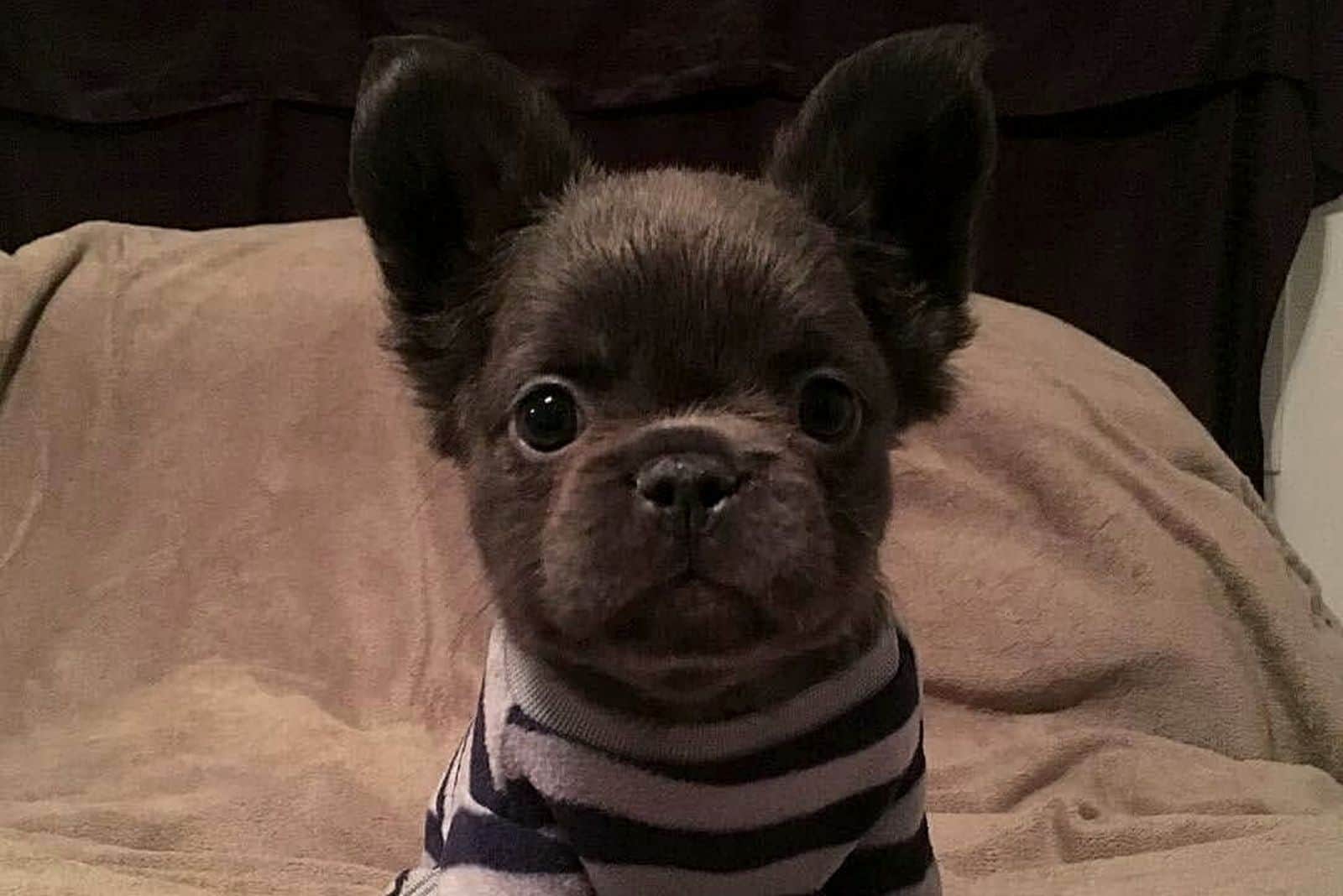
Fluffy French Bulldogs are expensive. The price for a Fluffy Frenchie ranges from $5,000 to $16,000, depending on your location, the puppy’s color, and the breeder. Female dogs usually cost more compared to male dogs.
For comparison, a standard-colored short-haired French Bulldog puppy costs between $1,500 and $3,000.
Rare-colored Frenchies, both short-haired and long-haired, will cost you more. The price of short-haired pups goes up to $7,000, depending on their color.
The price is also different for long hair gene carriers, usually purchased with further breeding in mind. It can be between $4,000 and $7,000.
Future owners need to consider the price of owning a Frenchie as well before they decide to get one. This includes veterinary care, food, pet insurance, and other doggy things like toys, clothes, and grooming tools.
There’s also the option of adopting. Although there aren’t many French Bulldogs in shelters, there are some puppies out there that need a new home. Owners sometimes have to give up their furry friends for various personal reasons, but being abandoned is never the dog’s fault, so why not give these pups a chance for a better life?
The main reason why Frenchies are so expensive is that their breeding isn’t easy. Because of their narrow hips and large heads, natural breeding is difficult, so they need to be artificially inseminated.
Since giving birth naturally would be difficult for females, a C-section is the safest way to deliver the puppies.
In conclusion
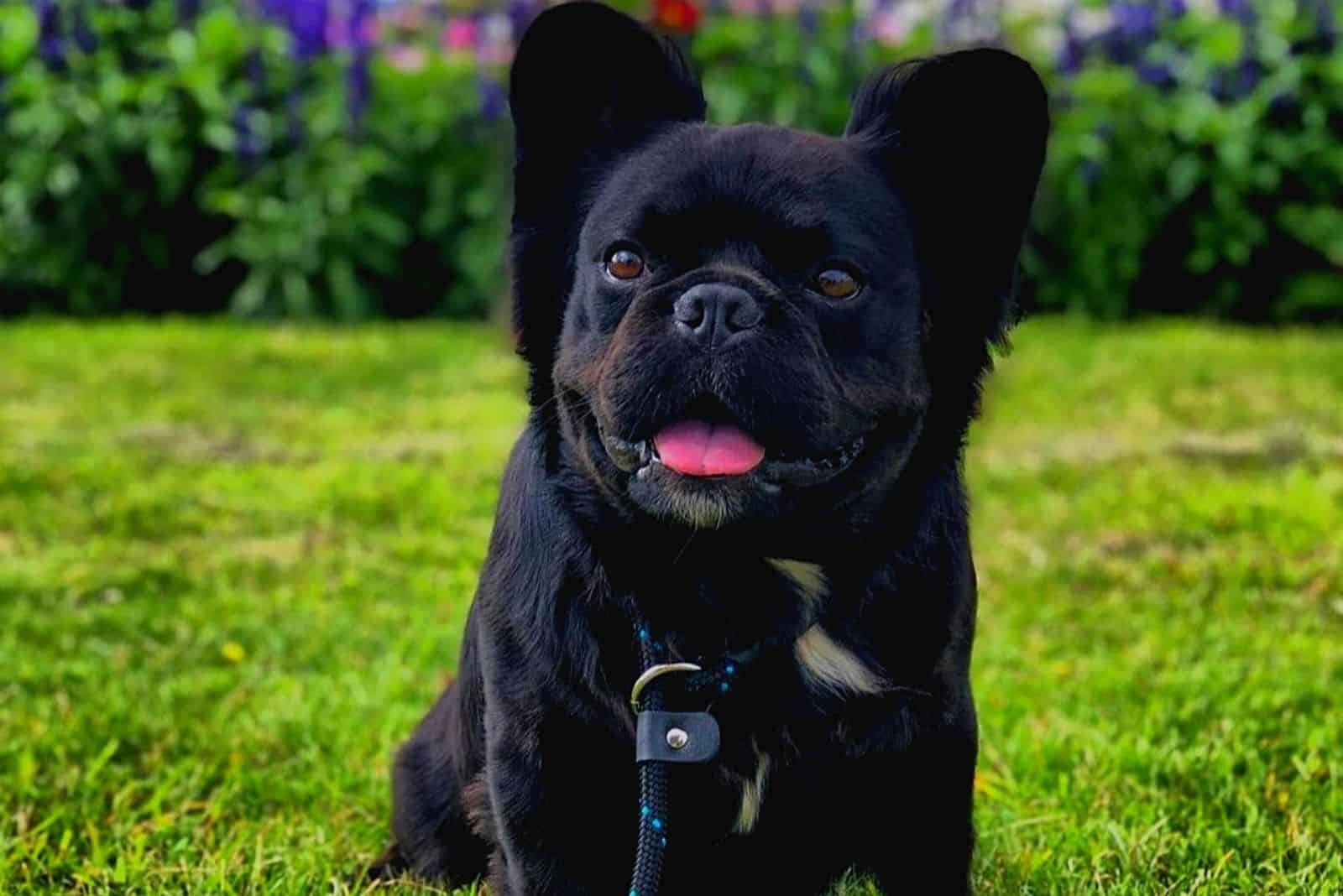
Not all Frenchies are short-haired. Although they are rare, long-haired Frenchies exist, and they may be even cuter than their cousins. They’ve already won the hearts of many dog lovers across the world.
Different theories explain the presence of long-hair genes in French Bulldogs. Some believe they were crossed with Pekingese or long-haired Chihuahuas in recent times to get the long-hair effect.
Others explain it by claiming that the ratter dogs carried the long-hair gene and transferred it to their descendants.
Owners have the ability to purchase a breed identification test and check for themselves whether their pup is, in fact, purebred.
Apart from the length of their coats, Fluffies look the same as their short-haired counterparts. The hair length doesn’t affect personality either, so they’re the same affectionate, playful pups as other dogs of their breed.
Unfortunately, the same goes for their health. Just like other French Bulldogs, they are prone to developing many health problems throughout their lives.
If you’re looking to get yourself a Fluffy puppy, you should consider the cost of future vet bills, alongside the dog’s price.
These pooches may not be welcome in dog shows, but if you welcome them into your home, they will surely fill your life with joy.


